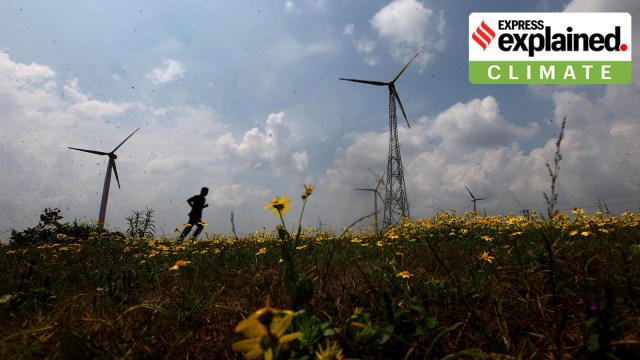‘Excessive preoccupation with temperature goal’: How India has signalled shift in approach to climate crisis
The recalibration of India’s position comes at a time when the international attention on climate action has tapered off a bit, despite 2023 and 2024 setting back-to-back temperature records. What is happening, and what is India's approach?
 India needs to scale up its manufacturing and technology capabilities related to clean energy. This would help it become less dependent on foreign supply chains. (Express Photo)
India needs to scale up its manufacturing and technology capabilities related to clean energy. This would help it become less dependent on foreign supply chains. (Express Photo)In the last year or so, India has signalled a subtle but important shift in the way it views the climate crisis and how it wants to deal with it. The country has questioned the “excessive preoccupation” of the international climate regime to achieve a specific temperature goal and argued that for developing countries like itself, adaptation must take precedence over reducing emissions.
India has also emphasised that rapid economic growth is the best defence against climate change for developing countries. Therefore, restrictions that constrain economic growth, such as curbs on the use of coal to generate electricity, are unacceptable.
These arguments themselves are not new. However, they are being made emphatically and with far greater clarity than before. This indicates an attempt by India to create space for greater flexibility in exercising its options on climate actions. It also provides the intellectual framework for the choices the country wants to make in this regard.
Slow progress on mitigation
The shift in India’s emphasis seems to be prompted by a reassessment of ground realities. The world is nowhere close to meeting its emissions reduction targets for 2030 or 2035 due to inaction largely on the part of the developed countries. In fact, global emissions are still on the rise.
There is, thus, very little incentive for a developing country such as India to allocate resources for mitigation efforts. Appreciable benefits of mitigation accrue only when the world as a whole reduces emissions by a significant amount. Also, these benefits are not witnessed immediately as global warming is caused not by the amount of greenhouse gases being emitted, but by their concentration in the atmosphere over time.
Adaptation, on the other hand, offers immediate and local benefits. Building up resilience against the impacts of climate change can be a better utilisation of limited resources. To a large extent, resilience is often a factor of prosperity. This is why India has argued that development is the best shield against the climate crisis.
The Economic Survey for 2024-25, released last week, asserted that India must first strive to attain developed country parameters by 2047 using available resources, and only then focus on achieving the net zero goal by 2070. This is significant as it can liberate India from the dilemma of carrying out aggressive decarbonisation while pursuing rapid economic growth.
In a sense, the Economic Survey is recommending that India follow the Chinese example. China has unreservedly prioritised economic growth and industrialisation without bothering about its emissions, which have grown four times from the mid-1990s. This was also when the international climate regime was established. The rapid economic growth has not just brought prosperity but also allowed China to build capabilities that will enable it to decarbonise faster than probably anyone else. The country now has the largest deployment of renewable energy, and the biggest production and manufacturing base for clean energy resources and technologies. Its emissions have still not peaked. However, once they do, possibly in the next couple of years, and China decides to start reducing emissions, it can shift to cleaner sources of energy much faster than any other country has so far managed to do.
Climate action on back-burner
The recalibration of India’s position comes at a time when the international attention on climate action has tapered off a bit, despite 2023 and 2024 setting back-to-back temperature records. Major events such as armed conflicts and technology wars have diverted the focus away from the climate crisis.
There has also been a growing frustration, especially among developing countries, with the inability of the international climate regime to deliver desired results. The meagre financial package agreed to at the COP29 conference in Baku, Azerbaijan, last year has eroded the trust of developing countries in this international process. They do not see their concerns being addressed adequately. Developed countries have not fulfilled their responsibilities on emission reductions and have been extremely stingy in meeting their financial obligations as well.
US President Donald Trump’s immediate withdrawal from the Paris Agreement after assuming office in January 2025, and his decisions to produce more fossil fuels, have brought a certain inevitability to the climate crisis going out of control.
For India, this means less pressure on issues such as coal phase-down . When countries with greater responsibilities, resources and capabilities have made energy choices irrespective of their impact on the climate crisis, India cannot be blamed for exercising similar options in its national interest.
Unique trajectory
However, all this does not mean abandoning decarbonisation altogether. India’s economic growth would still have to happen on low-carbon pathways, otherwise, there is the risk of being left out in the race to adopt clean energy and its related technologies. The pursuit of developed country parameters cannot be delinked from the clean energy transition. The two would reinforce each other and have to happen simultaneously.
Currently, India only seems to be asserting that the choices of low-carbon development, and the pace of energy transition, should be decided by itself and not dictated by others. While that is a fair and reasonable ask, it is more on India than the rest of the world to make this happen. For example, if manufacturing and technology capabilities related to clean energy are not scaled up significantly, India will continue to remain dependent on foreign supply chains. The country would also not be in a position to make independent choices on energy transition.
That is why the policy push to develop indigenous small modular nuclear reactors (SMRs), for example, is so critical. India has been rather slow in ramping up its nuclear energy capacities. The India-US civil nuclear deal and the special waiver at the Nuclear Suppliers Group should have enabled a rapid expansion of the nuclear power sector. That did not happen for a variety of reasons. Now, the SMRs offer a fresh opportunity to do so.
But nuclear power is only one part of the puzzle. Even if the ambitious target of 100 GW of nuclear energy by 2047 is met, it would form less than 10 per cent of India’s total electricity installed capacity. Every other clean energy option — solar, wind, and hydrogen — would need to be pursued aggressively over the next two decades for India to succeed in its climate objectives.
Photos




- 01
- 02
- 03
- 04
- 05


































